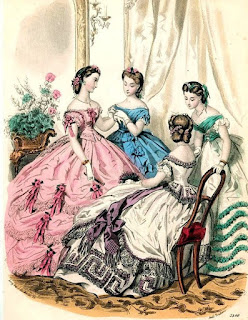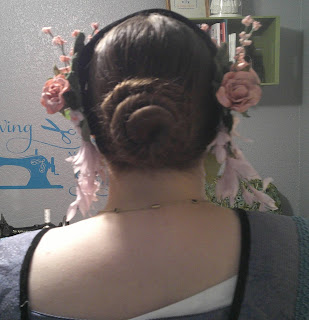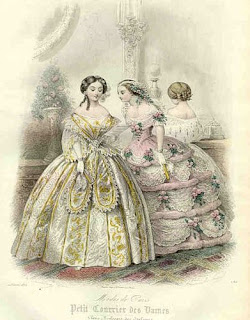Day Bodice
Evening Bodice
But still, things needed to be done with it. More with the day bodice than the evening one, but still, plenty of work to be done.
For the evening gown, just a few small tweaks were needed. The hooks and eyes needed to be redone as they were too large and spaced out too much. I also covered the edge of the Chantilly lace in a narrow velvet ribbon, after seeing the edges covered in original gowns.
 |
| Original from Time Traveler's Antiques. This was the original design inspiration for the Chantilly evening gown. The lace covering appears to be self fabric pleating. |
 |
| From Ebay. Looks to be covered with flat-applied velvet ribbon. |
 |
| Augusta Auctions. Lace is covered with a silk pleating. It's the same color as the dress fabric but appears to be different. |
As far as the bows, I ended up replacing the self fabric ones with a silver silk satin ribbon. You do see evening dresses trimmed with colors the same as the dress, and since this dress is a lilac shot with silver gown, I figured a silver ribbon would work.
 |
| Unknown fashion plate |
 |
| La Moda Elegante Illustrada, 1865 |
I didn't add a big bow at the neckline (where the original inspiration has a large cluster of flowers) because I figured I could put a brooch there instead. After making a pretty little tucker and attaching it, the evening bodice was done! The tucker is a pleated one, based on several originals like this one:
 |
| Unknown collection. |
No pictures of the back as I didn't have anyone to help me do the hooks and eyes therefore I am actually holding the bodice closed with one hand for the pictures!
Next up was the day bodice, which did need a fair bit of work. The whole bodice front was taken apart so I could extend it 1" on either side to accommodate a larger bust than the last time I wore this gown. Of course, this meant re doing the hooks and eyes and also cutting and making more piping. I also took out the pagoda sleeves and recut silk lining instead of the polished cotton lining it had. The lace had some breaks in it which had to be mended, then I used more velvet ribbon over the edge like the originals.
The last piece were the accessories. I already had partially done open undersleeves for the dress, I just had to add a second tier of whitework edging to them. I made a collar out of the same edging as well. I also had a handkerchief edged in the same whitework but I had gathered the whitework so I took it out and applied it flat (except at the corners) to more closely mimic originals.
After attaching these pieces to the day bodice, my work was done!
Enjoy!



















































